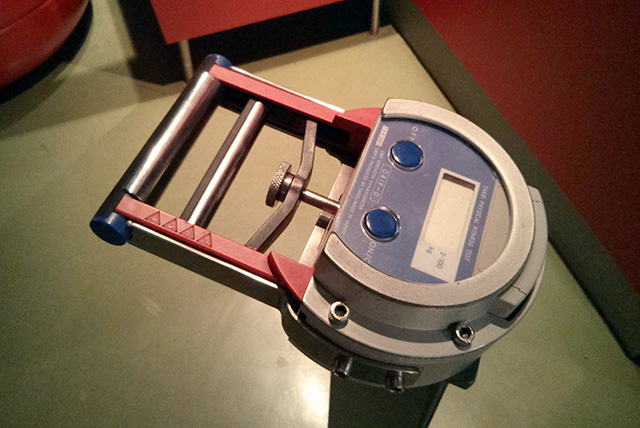The purpose of the handgrip strength test is to measure the maximum isometric strength of the hand and forearm muscles. Handgrip strength is important for any sport in which the hands are used for catching, throwing or lifting. Also, as a general rule people with strong hands tend to be strong elsewhere, so this test is often used as a general test of strength. See also the finger pinch strength test.
equipment required: handgrip dynamometer
pre-test: Explain the test procedures to the subject. Prepare forms and record basic information such as age, height, body weight, gender, hand dominance. Calibrate dynamometer, adjust to suit the subject. See more details of pre-test procedures.
procedure: The subject holds the dynamometer in the hand to be tested, with the arm at right angles and the elbow by the side of the body. The handle of the dynamometer is adjusted if required - the base should rest on the first metacarpal (heel of palm), while the handle should rest on middle of the four fingers. When ready the subject squeezes the dynamometer with maximum isometric effort, which is maintained for about 5 seconds. No other body movement is allowed. The subject should be strongly encouraged to give a maximum effort. See videos of the Handgrip Strength Test.
 handgrip dynamometer
handgrip dynamometervariations: The position of the arm and hand can vary in different grip strength protocols. Various positions include the elbow being held at right angles as per the above procedure, the arm hanging by the side, and the extended arm being swung from above the head to by the side during the squeezing motion. The Eurofit Test Manual recommends squeezing for 3 seconds. The procedure for the Groningen Elderly Tests has the subject hang their hand by their side, one practice trial, best of three attempts with 30 seconds rest between.
scoring: The best result from several trials for each hand is recorded, with at least 15 seconds recovery between each effort. The values listed below (in kg and lbs) give a guide to expected scores for adults. These values are the average of the best scores of each hand. See more Hand Grip Strength Norms. Other protocols will just use the score from the dominant hand, or compare the left and right hand results. See also examples of some actual athlete results.
| MALES | FEMALES | |||
|---|---|---|---|---|
| rating* | (lbs) | (kg) | (lbs) | (kg) |
| excellent | > 141 | > 64 | > 84 | > 38 |
| very good | 123-141 | 56-64 | 75-84 | 34-38 |
| above average | 114-122 | 52-55 | 66-74 | 30-33 |
| average | 105-113 | 48-51 | 57-65 | 26-29 |
| below average | 96-104 | 44-47 | 49-56 | 23-25 |
| poor | 88-95 | 40-43 | 44-48 | 20-22 |
| very poor | < 88 | < 40 | < 44 | < 20 |
validity: The validity of this test as a measure of general strength has been questioned, as the strength of the forearm muscles does not necessarily represent the strength of other muscle groups. If you wish to measure the strength of a particular muscle group, there are other specific tests that can be performed.
reliability: the dynamometer may need to be calibrated regularly to ensure consistent results. Having consistent technique and adequate rest is required to ensure reliability.
advantages: This is a simple and commonly used test of general strength level, well researched and many norms are available.
disadvantages: The dynamometer must be adjusted for hand size, how successfully this is done will affect the accuracy of the measurement.
comments:
- It is also useful to record whether the athlete is left or right handed, as this may help in the interpretation of results. The non-dominant hand usually scores about 10% lower.
- The forearm muscles are easily fatigued, so the best scores are usually achieved in the first or second trial.
- Results are expected to differ between male and females, between left and right (dominant and non-dominant) hands, and with age. The results can also be affected by the position of the wrist, elbow and shoulder, so these should be standardized. There are many other factors to consider - see Roberts et al. 2011.
References
- Helen C. Roberts, Hayley J. Denison, Helen J. Martin, Harnish P. Patel, Holly Syddall, Cyrus Cooper and Avan Aihie Sayer, A review of the measurement of grip strength in clinical and epidemiological studies: towards a standardised approach. Age Ageing (2011) 40 (4): 423-429.
Similar Tests
- See the similar finger pinch strength test
- Grip endurance is also measured using the Extended-Arm Hang Test
Related Pages
- Video examples of the Handgrip Strength Test
- Hand Grip Strength Testing FAQs
- This test is part of the Ice Hockey SPARQ rating, Eurofit Test Manual, Groningen Elderly Tests plus many others.
- More Hand Grip Strength Norms
- There are some grip strength test results of athletes.
- List of other strength tests.
- Calibrating Handgrip Dynamometers
Related Products
- Camry Hand Dynamometer
- Grip Strength Dynamometers on Amazon
- Grip strength trainers for sale online.


 Upcoming Events
Upcoming Events